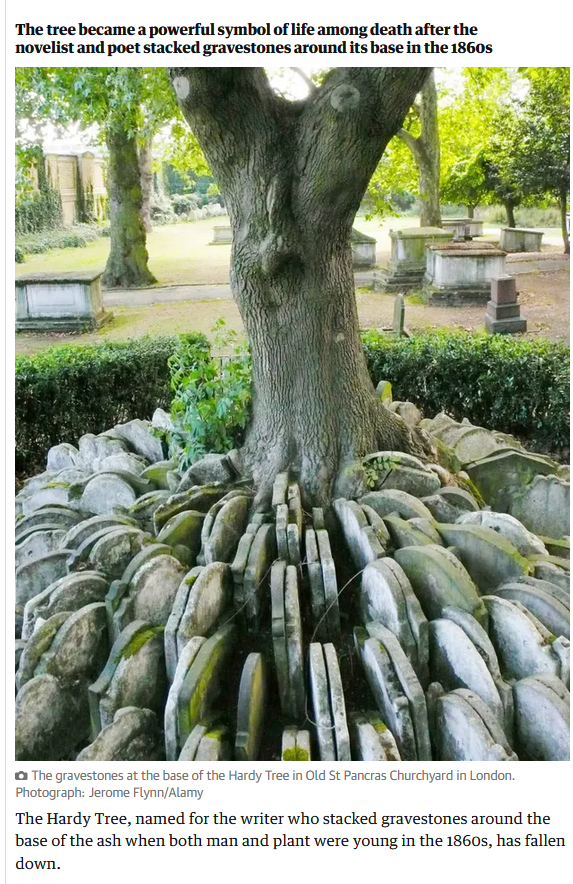I have updated my November 1st Post to include, among other improvements, new pictures of the Day of the Dead in Mexico.
Updates upon the Second Anniversary of my Almanac of the Past
I have updated the following two posts:
The End of Hardy’s tree

I published the following post about Hardy’s Tree on 28th December 2022. Here, follows the original post and an update which suggests the tree and the gravestones were not erected by Thomas Hardy.
This is the day that Herod ordered the slaughter of the Innocents, or Childermas, and I am glad to see that my Grandson is now older than Herod’s prescription.
Hardy’s Tree in St Pancras Church, Camden, London has fallen down. Hardy was an architect and worked in London for a while, where one of his jobs was to supervise the clearance of the graveyard. Several poems of Hardy refer to the removal of graves from their original positions and in this case, the gravestones were set around an Ash tree that inspires many, including my Central St Martin’s students who used it in a project recently. So, I was shocked to read a Guardian article (since deleted) which noted the sad demise of the Tree.
Extracts from one of several Hardy Poems about moving graves and gravestones follow, but I need to update the post about the connection to Hardy. The Guardian has now got an article which suggests the connection with Hardy is a more recent one than previously thought (Guardian article).
I (and I think the Guardian) were alerted to this by the work of Lester Hillman, who wrote a Churchyard Guide and a recent pamphlet about the Tree, which is reported in ‘Context ISSN 1462-7574’. This is the Journal of the City of London Archaeological Society. Evidence proves that the Ash Tree dates to the 1930s, and that the mound of gravestones is from burials relocated from St Giles in the Fields, and therefore unlikely to have been in St Pancras at the time Hardy was responsible for clearing it.
So it is not ‘the’ Hardy Tree, but then nor was the tree at Sycamore Gap anything to do with Robin Hood. What it was, was a beautiful piece of nature, in a poignant setting. May she rest in peace.
The Levelled Churchyard
Thomas Hardy
O Passenger, pray list and catch
Our sighs and piteous groans,
Half stifled in this jumbled patch
Of wrenched memorial stones!We late-lamented, resting here,
Are mixed to human jam,
And each to each exclaimed in fear,
I know not which I am.Where we are huddled none can trace,
And if our names remain,
They pave some path or porch or place
Where we have never lain!
Edinburgh. What a City!

This is a poem which is ‘printed’ on the side of the Scottish Parliament.
by Hugh MacDiarmid
But Edinburgh is a mad god’s dream
Fitful and dark,
Unseizable in Leith
And wildered by the Forth,
But irresistibly at last
Cleaving to sombre heights
Of passionate imagining
Till stonily,
From soaring battlements,
Earth eyes Eternity
Hugh MacDiarmid (1892-1978)

Henry Ford’s Love of the Cotswolds

Following my post where I introduced the story of Henry Ford and his visits to Broadway; my subscriber from Paris sent me details that led me to a really comprehensive description of Ford’s activities in the Cotswolds. He loved it so much, as the post from the Henry Ford Museum reveals, that he sent to the US not only a complete Cottage, but also the Barn, Stables and dry stone walling. He then went to stay in the Lygon Arms in Broadway; visited nearby Snowshill, where a dilapidated Blacksmith Shop dating to the 1600s with all its tools was purchased and sent to the Museum in Michigan.

Here is the post – it has lots of interesting photos.
And here is my post that introduced the subject:
Fury in France at Destruction of 7,000 Year-Old Standing Stones June 2023
Salon IF reported a shocking destruction in France – this is the report, verbatim from Salon IF issue 514.

Dozens of standing stones, erected over 7,000 years ago, have been demolished to make way for a DIY store near Carnac, in Brittany, in North West France. Some 37 stones, measuring between 0.5 – 1.5m tall, were removed despite the fact the site had long been on France’s National Archaeological Map. The stones, moreover, had been submitted to the tentative list of UNESCO World Heritage Sites (although the application had not yet been approved).
The region of Carnac is famous for its ancient ‘menhir’ – heavy, raised standing stones. Indeed, the area is often described as ‘the French Stonehenge’, with over 3,000 stone megaliths at the two sites of Menec and Kermario. There, the stone columns are arranged in long, straight rows and, according to the Carnac Tourist Office, it is the largest gathering of this type of standing stone in the world.
The land at the centre of the recent controversy, along the Montauban activity zone, had been granted a building permit by the local mayor’s office in August 2022 and construction of the new store, ‘Mr Bricolage’, was already underway. According to local amateur archaeologist, Christian Obeltz, who had originally raised concerns about the ‘brutal developments’, a bulldozer destroyed the stones overnight.
The Regional Office of Cultural Affairs for Brittany, the body responsible for the protection of the monument, said ‘Given the uncertain and in any case non-major character of the remains, as revealed by

checks, damage to a site of archaeological value has not been established’, but Obeltz maintains that archaeological investigation into the area had not been sufficient.
‘The Chemin de Montauban site included two intersecting rows of small granite stelae, each spreading out over fifty meters in length. One had been exactly in its original place for 7,000 years,’ according to Obletz. ‘The small menhirs of the Chemin de Montauban were undoubtedly one of the oldest sets of stelae in the town of Carnac’ believed to date between 5480 and 5320 BC, ‘the highest dating obtained for a menhir in the west of France’.
Link to the Picture Room Virtual tour that works

The link to the Sir John Soane Picture Room Virtual Tour in yesterday’s post did not work. For some reason, the URL displayed in the browser for the Picture Room tour does not work. I think the Museum must have disabled it. They might want us to come into the virtual tours at the previous level, where you get a choice of the three virtual tours they currently offer.
So this is the link you need. (choose Picture Room from the three options).
Further information about the Picture Room can be found here: the Picture Room and the paintings.
Digital Heritage – the Picture Room at the Sir John Soane Museum

The Sir John Soane Museum is my second favourite London Museum. It’s the place I choose to take people who don’t know London. What I like about it is the atmosphere. It’s not a place I go because of the collection, it’s a place I go because I’m just awestruck when I enter the doors.
Architect Soane, made a Museum of his house, filling it with architectural and sculptural pieces but also some stupendous Art, particularly paintings by William Hogarth. But that isn’t my motivation to keep going back. It’s the Picture Room (and the domed ceilings). Soane had a great collection of paintings, but not enough walls. What he did was to design the Paintings Room. When you visit you go in, admire the paintings on the wall, and the attendant comes in, opens a shutter, and behind the great paintings are another wall of great paintings. And then he opens another set of shutters, and there, is another feast for your eyes.
Now, they have made high quality digital images of the rooms, and put them together using photogrammetry into a digital model which you can explore.
So, feast your eyes on it here: (choose Picture Room from the three options).
It’s not quite as user-friendly as it might be. Firstly, when the tour delivers you to the Picture Room, you have to take over control to go in and explore the 360 degree image of the room. Unfortunately, the pictures are not clickable, so you cannot get information about them from here. Also, the ‘hot spots’ which allow you to open the shutters, only reveal themselves, on my computer, if you approach them at a certain angle.
But don’t let this put you off, I’m sure you will find your way around. So go into the Room, look around, move the cursus, and you will see little signs pop up which open and close the shutters. Really, do try it! There are a couple of other rooms to explore too.
Here is a link to descriptions of the Picture Room and the paintings.
Oh, and the Dome Ceilings? Soane was a specialist in buildings that didn’t want windows in normal places. He was the architect of the Bank of England where windows in the walls were a security risk, and also of London’s first purpose built art gallery – the Dulwich Picture Gallery. Windows reduced the space for paintings, so he designed special low domed ceilings, and the Soane Museum is full of his experimentation in the form.
Scara Brae Three D Model
Another delight is the 3D model of Scara Brae which allows you to explore the Neolithic village, and walk around it. There are labels on this one, so you do get information too.
360 Degree Panorama Virtual Tours. My part in their development.
I was an early adopter of this form of virtual reality, setting up virtual tours of the Old Operating Theatre Museum in the 1990’s. I have a draft post of this which I have been awaiting time to finish, which I hope to finish soon….
Thanks to the Museum’s Journal article on Photogrametry of May/June 2022 for the two examples above.
May Gifts & New Brooms

It’s bad luck to buy, make or use a new broom in May because:
Sweep with a broom that is cut in May
You’ll sweep the head of the house away.
But you can give good luck to a friend by leaving a branch of hawthorn flowers on the doorstep. But other woody messages were not so friendly according to traditional verses:
Alder for a scrowler; pear for the fair
Nut for a Slut; plum for the glum
Bramble if she ramble; gorse for the whores
It is basically rhyming slang, so no great wisdom involved, also I’m not sure quite how some of the rhymes work, and it does seem rather at the expense of women.
50th Anniversary of ‘Small Is Beautiful’

It was, probably, mid 70s when I came across this book and, I think I can say, it had a lasting effect on my opinions. The book is about many things, but what it did for me was introduce sustainable development and the beauty of small scale innovation. Schumacher believed that resources were limited, that pollution represents an ever-increasing danger to society, and that appropriate scale innovation offered the best hope to create a fairer world.
He helped set up ‘the Intermediate Technology Development Group’, but found a better title in ‘Small is Beautiful’ for his book outlining his philosophy. ITDG became Practical Action, which is a charity that works around the world finding innovative solutions to real world problems.
To see Schumacher’s legacy have a look at the Practical Action web site or follow this link to see what it is doing, for example, in promoting ‘regenerative agriculture.’
I donate regularly, and maybe you might enjoy reading positive stories of human ingenuity in action around the world.
